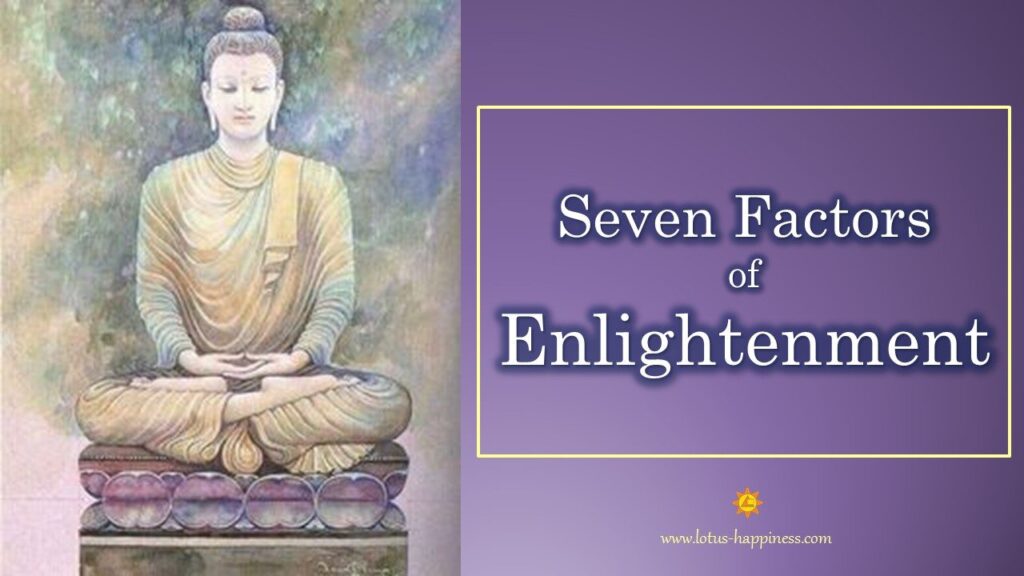By Dr. Ari Ubeysekara

Seven Factors of Enlightenment (satta bojjhanga) in Theravada Buddhism
Introduction
The final spiritual goal of the Buddhist practitioners within Theravada Buddhism is to attain enlightenment or liberation from all suffering and the cycle of birth and death (samsara). This is the state of Nibbana, which has been described as a supra-mundane state of the highest bliss and eternal happiness devoid of the suffering of birth, disease, old age, death, grief, lamentation and despair.
In many of His discourses the Buddha has stated that, in order to attain final liberation one has to cultivate 37 qualities in one’s mind. These 37 qualities or requisites are known as “Bodhipakkhiya dhamma” in the Pali language, “bodhi” meaning awakening or enlightenment, “pakkhiya” meaning related and “dhamma” meaning requisites or qualities which are described in seven groups.
The thirty seven requisites of enlightenment
- Four foundations of mindfulness (satipatthana)
- Four types of right effort (sammappadana)
- Four bases of mental power (iddhipada)
- Five spiritual faculties (panchaindriya)
- Five spiritual powers (panchabala)
- Seven factors of enlightenment (sattabojjhanga)
- The Noble Eight-fold Path (ariyaatthangika magga)
Seven factors of enlightenment (satta bojjhanga)
The Pali term “Satta bojjhanga” consisting of “satta” meaning seven, “bodhi”, meaning enlightenment and “anga” meaning causative factors refer to the following seven factors or necessary conditions which, when cultivated by a disciple lead to awakening or enlightenment;
- Mindfulness (sati)
- Investigation of dhammas (dhamma vicaya)
- Energy or effort (viriya)
- Rapture or joy (piti)
- Tranquility (passaddhi)
- Concentration (samadhi)
- Equanimity (upekkha)
By developing the seven factors of enlightenment and entering the supra-mundane path of awakening, one becomes a noble person (ariya) from being an ordinary worldling (puthujjana) before. According to the Buddhist scriptures, the seven factors of enlightenment are known in the world only when a Samma Sambuddha has appeared and they are disclosed to the world only by a Sam Sambuddha. Hence, they are wholesome factors that are unique to the Buddha’s teaching. When these seven factors are fully cultivated and mature, the meditator attains the path consciousness (magga nana) with the realization of the four Noble Truths. This is the experience of the state of Nibbana with the total elimination of mental defilements and thus becoming a noble person (ariya). So, this set of seven factors of enlightenment is also described as qualities of a noble person or an enlightened person.
Beginning with the first factor of mindfulness (sati) they tend to flow in a progression towards the last factor of equanimity (upekkha) with each factor supporting the development of the subsequent factors. During the spiritual journey of a Buddhist disciple these seven factors can be present in varying stages of maturity. When they are fully developed and mature during insight meditation (vipassana bhavana), one attains the insight knowledge of the supra-mundane path (lokuttara-magga-nana) which is also known as “Sambodhi”; full awakening to the four Noble Truths. Hence, in the Buddhist literature the seven factors of enlightenment are also known as “Satta sam-bojjhanga”.
Appropriate or wise attention (yoniso manasikara) plays a crucial role in the establishment and development of the seven factors of enlightenment. The Buddha has stated that no other internal factor is more important than wise attention in developing the seven factors of enlightenment. Wise attention can be described as the thinking in terms of causal relationships such as the consequences of one’s thoughts and actions, or exploration of the conditioned nature of phenomena which will lead to the development of insight or wisdom. According to the Ahara Sutta of the Samyutta Nikaya (collection of the Buddha’s connected discourses), when there is unwise attention (ayoniso manasikara), un-arisen factors of enlightenment do not arise and those that have arisen will not reach the culmination of their development. When there is wise attention (yoniso manasikara), un-arisen factors of enlightenment will arise and those that have arisen will reach the culmination of their development (1).
The Buddha has often stated the significance of association with a spiritual friend (kalyana mitta sevana), in one’s spiritual development. For example, when on a certain occasion, Venerable Ananda, the Buddha’s chief attendant, stated to the Buddha that he thought association with a spiritual friend is half of the Buddha’s dispensation, the Buddha corrected him by stating that the Buddha’s dispensation totally depends on association with a spiritual friend. The Buddha has also stated in the Samyutta Nikaya, that there is no other external factor more significant and helpful in the development of the seven factors of enlightenment than association with spiritual friends.
- Mindfulness (sati)
Although the Pali word “Sati” has several meanings such as memory, mindfulness, recollection and wakefulness, here, it is considered as the mindful-awareness to the content of one’s experience as it manifests from moment to moment in the immediate present. Mindful awareness is paying bare attention to whatever happens from moment to moment, whether it is a physical or a mental process, without any reaction or judgment in order to have an insight into their true nature. One is expected to keep full awareness on what is happening right now, not paying attention to the past which is already gone or to the future which is yet to come. Mindfulness has been mentioned several times within the 37 requisites of enlightenment;
- Mindfulness as the four foundations of mindfulness (satipatthana)
- Mindfulness as the 7thfactor of the Noble Eight-fold Path (ariya attanghika magga)
- Mindfulness as one of the five spiritual faculties (pancha indriya)
- Mindfulness as one of the five spiritual powers (pancha bala)
Non-judgmental awareness from moment to moment needs to be maintained continuously at each moment of one’s waking life for it to become a factor of enlightenment. As a factor of enlightenment, mindfulness has a central role not only because it is an essential factor for the development of the other six factors but because it’s continual presence is also essential as a balancing factor for the other six factors to mature and become factors of enlightenment.
Through well developed mindfulness one is able to maintain equanimity towards the sense experiences received through the six sense organs of eye, ear, nose, tongue, body and the mind. As such, by not reacting with craving to pleasant sense objects or with aversion to unpleasant sense objects, one is able to exert control over the process in which unwholesome mental roots of greed (raga), aversion (dosa) and delusion (moha) may lead to unskillful mental, verbal or physical actions.
The technique of developing mindfulness in insight meditation is derived from one of the most important discourses by the Buddha named Satipatthana sutta. “Sati” means mindfulness, and “patthana” means foundation, so Satipatthana means foundations of mindfulness. In the Buddha’s teachings recorded in the Pali language, Satipatthana sutta appears as the 10th discourse of the middle length discourses (majjhima nikaya).
In this sutta, the Buddha has given clear guidelines on how to develop the complete set of four foundations of mindfulness.
The four foundations of mindfulness
- Contemplating the body in the body (kayanupassana)
- Contemplating feelings in the feelings (vedananupassana)
- Contemplating mind in the mind (cittanupassana)
- Contemplating mind objects in mind objects (dhammanupassana) (2)
The Buddha has persistently emphasised the fact that in order to achieve spiritual outcome as described by the Buddha, the meditator needs to develop the four foundations of mindfulness with diligence (atapi), clear comprehension (sampajanna) and mindfulness (sati) leading to the development of mindfulness as a factor of enlightenment and insight wisdom (panna).
In the Anapanasati sutta, the 118th discourse of the Buddha’s middle length discourses (majjhima nikaya), the Buddha has given very clear instructions on establishing mindfulness of breathing (anapanasati) followed by sixteen contemplations divided into four sets or tetrads. The four tetrads of contemplations correspond to the four foundations of mindfulness described in the Satipatthana sutta namely, contemplation of the body (kayanupassana), contemplation of the feelings or sensations (vedananupassana), contemplation of the mind or consciousness (cittanupassana) and contemplation of the mind objects (dhammanupassana). The Buddha has assured that by the practice of the sixteen contemplations successfully, mindfulness (sati) factor of enlightenment will develop followed by the rest of the factors leading to insight knowledge and full liberation (3).
Four factors have been described in the Buddhist literature which can strengthen the development of mindfulness as a factor of enlightenment.
- Mindfulness with clear comprehension (sati sampajanna)
- Avoiding association with confused and unmindful persons
- Association with persons who cultivate mindfulness
- Strong commitment towards developing mindfulness
In mindfulness with clear comprehension one maintains mindfulness during the performance of all daily activities such as walking, talking, dressing, eating, washing, toileting, sleeping etc. If one associates with people who lack mindfulness and has no inclination to even consider developing mindfulness it would be just a matter of time before one become influenced by them while association with people who are mindful and are inclined to develop mindfulness will be a positive influence (4).
- Investigation of dhammas (dhamma vicaya)
The second factor of dhamma vicaya, “dhamma” meaning mental and physical phenomena and “vicaya” meaning to analyse, investigate or scrutinize, refers to the quality of mind that critically discriminates and investigates into the true nature of mental and physical phenomena (nama-rupa). This investigation is not an intellectual or a thinking process but an analytical and intuitive process in the context of meditation, scrutinizing and penetrating into the reality of all existing phenomena as they happen from moment to moment in one’s experiential world.
Investigation of dhammas (dhamma vicaya) is a designation for wisdom and has been described in different names elsewhere in the Buddha’s teaching such as;
- Right view (samma ditthi) as the first factor of the Noble Eight-fold Path
- Investigation or discrimination (vimansa) as one of the four bases of mental power (iddhipada)
- Wisdom (panna) as one of the five spiritual faculties (pancha indriya) and
- Wisdom (panna) as one of the five spiritual powers (pancha bala)
Through investigation, one gains an analytical knowledge about the true nature of the mental and physical phenomena consisting of the three universal characteristics of impermanence (anicca), unsatisfactoriness (dukkha) and absence of a self (anatta). Well developed mindfulness (sati) helps the process of critical investigation into the phenomena as they arise and cease leading to the insight into the difference between mind (nama) and matter (rupa) and the conditioned nature of the arising and ceasing of mental and physical phenomena (paticca samuppada). Hence, this factor of enlightenment is also known as investigation of phenomena. While mindfulness is rather a passive process, investigation of dhammas is an active process analyzing, scrutinizing and dissecting mental and physical phenomena to get an understanding of the reality of their true nature.
Sometimes investigation of dhammas or phenomena has also been referred to as critical investigation of the Buddha’s teaching (Dhamma) itself where one critically and analytically examines significant aspects of the teaching such as the four Noble Truths, three universal characteristics and Dependent Origination. However, both interpretations amount to the same process as the function of both is to critically analyse the mental and physical phenomena from moment to moment to gain an insight into their true nature.
The factor of investigation of the dhammas can be developed by paying wise attention to qualities such as wholesome/unwholesome, blamable/blameless, inferior/superior and evil/good. For example, one could investigate unwholesome qualities which will bring suffering such as craving, aversion, anxiety, and fear as they arise in our mind and also wholesome qualities such as loving kindness, compassion and generosity.
In the Buddhist literature seven more factors have been described which can facilitate the development of the factor of investigation of dhammas (dhamma vicaya):
- Inquiring about various aspects of the Buddha’s teaching and practice
- Cleanliness of one’s physical body and the surroundings
- A proper balance among the five spiritual faculties of faith (saddha), effort (viriya), mindfulness (sati), concentration (samadhi) and wisdom (panna). A proper balance needs to maintained between faith and wisdom as well as between effort and concentration, mindfulness acting as the moderator
- Association with wise persons. A wise person has been described as someone who, through insight meditation has gained at least the insight into the arising and ceasing of mental and physical phenomena
- Avoiding association with unwise persons
- Reflection on hard to perceive processes such as the five aggregates of clinging, the base elements, six sense bases etc.
- Having a mental state inclined towards the development of investigation of dhammas in all the postures; standing, sitting, walking and lying down
The development of the factor of investigation of dhammas (dhamma vicaya) is facilitated by the preceding factor of mindfulness (sati) and leads to the establishment of the subsequent factors of effort (viriya), rapture (piti), tranquility (passaddhi), concentration (samadhi) and equanimity (upekkha).
- Energy or effort (viriya)
Effort is an essential factor that is required for the cultivation and maturation of the seven factors of enlightenment. Steady, energetic and consistent effort is required to abandon harmful mental qualities and to facilitate the arising and nurturing of mental qualities which are beneficial to the spiritual development. In the Buddhist literature the significance of effort is mentioned in the context of several other areas with in the thirty seven requisites of enlightenment.
- Effort as four right efforts (cattaro sammappadhana)
- Effort as one of the four bases of mental power (viriya iddhipada)
- Effort as one of the five spiritual faculties (pancha indriya)
- Effort as one of the five spiritual powers (pancha bala)
- Right effort (samma vayama) as the sixth factor of the Noble Eight-fold path
The degree of effort that the Buddha applied in search of the Truth on the night of enlightenment while sitting under the Bodhi tree in Bodh Gaya, Northeast India is shown by His determination;
“Though only my skin, sinews and bone may remain, and my blood and flesh may dry up and wither away, yet will I never move from this seat until I have attained full enlightenment”
In applying effort (viriya) to develop one’s spiritual development it needs to be maintained from the beginning till the final liberation and depending on the stage of a particular task there are three types of effort:
- Effort required to begin a particular action (arambha dhatu viriya)
- Effort required to sustain an action in spite of obstacles (nikkama dhatu viriya)
- Effort required to continue till the completion of an action (parakkama dhatu viriya)
Within the thirty seven requisites of enlightenment there are four types of right effort:
- To prevent the development of unwholesome mental states that have not arisen
- To abandon the unwholesome mental states that have arisen
- To cultivate the un-arisen wholesome mental states
- To maintain the wholesome mental states that have arisen
The unwholesome mental sates that have not yet arisen are the five mental hindrances of sensual desire (kamacchanda), ill-will (vyapada), sloth and topor (thina middha), restlessness and remorse (uddacca kukkucca) and sceptical doubt (vicikicca). Effort should also be applied to abandon thoughts of sensual desire (kama sankappa), hatred (vyapada sankappa) and cruelty (vihimsa sankappa) that have already arisen. The wholesome mental states that need to be developed and maintained with right effort are the seven factors of enlightenment (satta bojjhanga).
- Rapture or joy (piti)
Joy, pleasure or happiness can be either sensual joy or non-sensual joy. Sensual (samisa) joy is the happiness created by the sensual objects received through the six sense doors of the eye, ear, nose, tongue, body and the mind. On the other hand, rapture or non-sensual (niramisa) joy, also known as spiritual happiness and pleasurable interest in a meditation object, is the pleasure or bliss that one feels in the mind and the body associated with well developed concentration and the peace of the mind through meditative experiences. It creates a feeling of contentment and refreshment for the mind and the body.
Compared to calmness (passaddhi), the next factor of enlightenment to be discussed, rapture has a rather exciting and energizing quality which would naturally stimulate the meditator to continue and persist with meditation. Rapture is not felt as a physical sensation. It appears when the mind is free from the five mental hindrances and is present as a jhanic factor in the first two states of deep absorption (jhana).
Rapture is one of the five qualities or attributes called Jhanic factors which develop when the mind is in a state of deep concentration;
- Initial application (vitakka)
- Sustained application (vicara)
- Rapture or joy (piti)
- Mental bliss or happiness (sukha)
- One-pointedness with equanimity (ekaggata with upekkha)
Five different types of rapture which can refresh the body and the mind have been described by Bhadantacariya Buddhaghosa in the Path of Purification (visuddhimagga);
- Minor rapture (khuddaka piti)
- Momentary rapture (khanika piti)
- Showering rapture (okkantika piti)
- Uplifting rapture (ubbenga piti)
- Pervading rapture (pharana piti)
Minor rapture generally appears first and can make the hair on the body to rise while in momentary rapture, which is of very short duration, there are flashes of rapture at different moments which appears and disappears like flashes of lightening. Showering rapture invades the body again and again similar to the waves on the sea shore and in uplifting rapture the body is likely to be lifted off from the ground. Pervading rapture pervades and fills the whole body with joy and is described as the jhanic factor of rapture (5).
The appearance of rapture (piti) is an indication that the mind has reached a deep state of concentration with the suppression of the five mental hindrances, but the meditator should not get attached to it and continue with the primary meditation object as otherwise it will hinder further mental development.
- Tranquility (passaddhi)
The fifth factor of calm, serenity, quietness or tranquility (passaddhi) naturally follows joy or rapture (piti) and leads on to concentration (samadhi). It is of two types;
- Tranquility of the mental qualities (kaya passaddhi)
- Tranquility of the mind or consciousness (citta passaddhi)
Kaya passaddhhi is not quietening of the physical body, but of the mental factors (cetasika) such as feeling (vedana), perception (sanna) and the mental formations (sankhara). When tranquility develops the opposite factors of restlessness and remorse (uddaccha kukkuccha) are controlled. For tranquility to develop, the previous four factors of mindfulness, investigation, effort and rapture need to have been well developed. When the mind is in such a state of peace and quietness there is the danger that the meditator will misinterpret it as a stage of liberation and discontinue with further development of the mind. Tranquility has been compared to the happy and relaxing experience provided by the cooling shade of a tree to someone who is affected by the severe heat of the sun. It has a controlling effect on the mental hindrances of restlessness (uddacca) and remorse (kukkucca) which can exert a negative influence on the peaceful nature of the mind (citta) and the mental factors (cetasika).
- Concentration (samadhi)
Concentration (samadhi) has been described as “the state, in virtue of which, consciousness and it’s concomitants remain evenly and rightly on a single object un-distracted and un-scattered”. It is an essential factor in the spiritual journey within Theravada Buddhism. Cultivation and the maturity of the first five factors of mindfulness, investigation, effort, rapture and tranquility is essential for the proper development of concentration as a factor of enlightenment. Concentration is mentioned in several other groups within the thirty seven requisites of enlightenment;
- Concentration as one of the five spiritual faculties (samadhindriya)
- Concentration as one of the five spiritual powers (samadhibala)
- Right concentration in the Noble Eight-fold Path (samma samadhi)
In concentration meditation a state of deep concentration or one-pointedness of mind is cultivated by focusing one’s attention on one of the forty meditation objects. This state will be maintained as long as the attention of the meditator is completely absorbed into that particular object. When the meditator keeps concentrating on the chosen meditation object on a continuous basis and as the concentration gradually deepens, two stages of concentration (samadhi) can be attained;
- Access concentration (upachara samadhi)
- Fixed concentration (appana samadhi)
In access concentration, also called neighbourhood concentration, the attention on the meditation object becomes more sustained and powerful fixing the mind one-pointedly along with the suppression of the five mental hindrances.
In fixed concentration, in addition to fixing the mind on the meditation object one-pointedly and suppression of the five mental hindrances, the five Jhanic factors are also strong and well developed. The mind can now remain in deep concentration continuously and the meditator can experience tranquility, calmness and bliss.
As the concentration of the mind becomes deeper and deeper, different stages of calmness and joy called Jhana or deep mental absorptions arise which are free from the five mental hindrances. In addition to attaining the states of deep mental absorptions and tranquility, the deep state of concentration and the removal of the mental hindrances can equip the mediator to properly investigate and attain insight or wisdom into the real nature of mental and physical phenomena (nama rupa); impermanence (anicca), unsatisfactoriness (dukkha) and not self (anatta).
Some meditators may prefer to develop the concentration up to the level of fixed concentration (appana samadhi) or even up to the level of deep absorption states (jhana) before going onto practise insight meditation (vipassana bhavana). However, it is said that concentration up to the level of access concentration (upacara samadhi) with the suppression of the five mental hindrances is enough for one to practise insight meditation. For the meditators who prefer to practise insight meditation right from the beginning of the practice without practising concentration meditation first, what is known as momentary concentration (khanika samadhi) would be enough to proceed with insight meditation. While paying attention with mindfulness to mental and physical phenomena as they arise and cease, but not getting absorbed into them as done in concentration meditation, moment to moment concentration develops which is equivalent to access concentration (upacara samadhi) with the suppression of the five mental hindrances.
Out of the five spiritual faculties of faith or conviction (saddha), effort (viriya), mindfulness (sati), concentration (samadhi) and wisdom (panna), there has to be a proper balance between the factors of effort and concentration, for the concentration to develop and mature as a factor of enlightenment. If effort dominates over concentration it will cause restlessness and agitation whereas when concentration dominates over effort it will cause sloth and torpor.
- Equanimity (upekkha)
Equanimity is the mental quality of being non-reactive and neutral with a perfectly balanced mind, in the face of different experiences. It’s development as a factor of enlightenment is facilitated by the proper development of the preceding six factors of enlightenment. Equanimity is the last of the four immeasurables (brahma vihara), the others being loving kindness (metta), compassion (karuna) and sympathetic joy (muditha). These four immeasurables are included among the forty meditation objects used in concentration meditation. Equanimity is also one of the five factors associated with deep absorption stages (jhana) in concentration meditation.
It should be noted that equanimity as a factor of enlightenment is not considered as a neutral feeling but as a mental attitude of balance and impartiality synonymous with the neutrality of the mind (tatramajjhattata), one of the nineteen universal beautiful mental factors (sobhanasadharana-cetasika) mentioned in the Buddha’s higher teaching (abhidhamma) (6).
When equanimity has become a factor of enlightenment one is able to deal with one’s experiences with people and objects with an impartial attitude with no attachment or detachment. Hence, a Buddha’s disciple who has attained the final noble stage of the spiritual development known as Arahant with well developed equanimity as a factor of enlightenment will face the following worldly experiences with total equanimity;
- Gain (labha) and loss (alabha)
- Disrepute (ayasa) and fame (yasa)
- Blame (ninda) and praise (pasamsa)
- Pleasure (sukha) and pain (dukkha)
For equanimity to develop as a factor of enlightenment there has to be a proper balance among the five spiritual faculties (pancha indriya). Of the five spiritual faculties, the faculties of faith (saddha) and wisdom (panna) are paired together while effort (viriya) and concentration (samadhi) are paired together in a reciprocal relationship. There has to be a balance between faith and wisdom as well as between effort and concentration to facilitate spiritual progress. The faculty of mindfulness (sati) which is the basic condition for the other four factors, acts as the moderator to make sure that each pair maintains the correct balance between them without resorting to either extreme.
In the Aggi Sutta of the Samyutta Nikaya (collection of the Buddha’s connected discourses) the Buddha has advised the monks that when the mind is sluggish due to the mental hindrance of sloth and torpor (thina middha), it is the wrong time to practise the factors of concentration, tranquility and equanimity, but is the right time to practise effort, investigation and rapture. Similarly, when the mind is restless due to the mental hindrance of restlessness and remorse (uddacca kukkucca), it is the wrong time to practise effort, investigation and rapture, but is the right time to practise concentration, tranquility and equanimity (7).
In the discourse on the Foundations of Mindfulness (satipatthana sutta) of the Majjhima Nikaya (collection of the Buddha’s middle length discourses), the Buddha has described contemplation of the seven factors of enlightenment as a means of developing mindfulness of mind objects (dhammas). For example, in contemplating the factor of mindfulness as just a mental object, the mediator is aware;
- When the mindfulness factor has arisen
- When the mindfulness factor has not arisen
- When the un-arisen mindfulness factor arises, and
- When the arisen mindfulness factor reaches its completion
In a similar way the meditator contemplates with regard to the other six factors of enlightenment. The meditator thus contemplates the seven factors of enlightenment as just phenomena with no “I”, “Self” or “Soul” in him-self and others, detached and without clinging to anything (8).
Within the group of the seven factors of enlightenment there are two sub groups each consisting of three of the seven factors. One sub group is the arousing or the energising group consisting of the three factors of effort (viriya), investigation (dhamma vicaya) and rapture (piti), while the other sub group known as the calming or the passive group consists of concentration (samadhi), tranquility (passaddhi) and equanimity (upekkha). Mindfulness (sati) acts as the moderating and the balancing factor to make sure that the other six factors develop and mature in a correct balance.
In the Sila sutta of the Bhojjanga samyutta of the Samyutta Nikaya, the Buddha has described seven benefits of cultivating the seven factors of enlightenment (9).
- One becomes an Arahant early in this life itself.
- If not, one becomes an Arahant at the time of death.
- If one does not become an Arahant in this life, having eradicated the first five fetters of self. identity view (sakkaya ditthi), sceptical doubt (vicikicca), attachment to mere rites and rituals (silabbata paramasa), sensual desire (kama raga) and ill-will (patigha) and become a Non-Returner, one will be reborn in one of the five Brahma worlds called Pure Abodes (suddhavasa) and become an Arahant during the first half of the life span there (antara parinibbayi).
- Having been born in a Pure Abode as a Non-returner, one will become an Arahant during the second half the life span there (upahacca parinibbayi).
- Having been born in a Pure Abode as a Non-Returner, one will become an Arahant with effort (sasankhara parinibbayi).
- Having been born in a Pure Abode as a Non-Returner, one will become an Arahant with no effort (asankhara parinibbayi).
- Having been born in a Pure Abode as a Non-Returner, one will move upwards in the Pure Abodes till the Akanittha Pure Abode and become an Arahant there (uddhamsota akanittha-gami).
In the Anapanasati sutta of the Majjhima Nikaya, the Buddha has stated that when the sixteen contemplations divided into the four tetrads are practised and mindfulness of breathing is cultivated regularly it brings the four foundations of mindfulness namely; mindfulness of the body (kayanupassana), mindfulness of feelings (vedanaupassana), mindfulness of the mind (cittanupassana) and mindfulness of mind objects (dhammanupassana) to perfection. In the same sutta the Buddha goes on to state that when a meditator cultivates and regularly practises the four foundations of mindfulness it will lead to the development of the seven factors of enlightenment (satta bojjhanga) to perfection followed by the perfection of true knowledge (vijja) and liberation (vimutti) (10).
References
- Bhikkhu Bodhi 1999, Ahara sutta, The Connected Discourses of the Buddha, A Translation of the Samyutta Nikaya, Wisdom Publications.
- Soma Thera 2003, The Way of Mindfulness, Buddhist Publication Society, Kandy,Sri Lanka.
- Ledi Sayadaw Mahathera 1999, Manual of Mindfulness of Breathing, Anapana Dipani, Wheel Publication No: 431/432, Buddhist Publication Society, Kandy, Sri Lanka.
- Soma Thera 2003, The Way of Mindfulness, Buddhist Publication Society, Kandy,Sri Lanka.
- The Path of Purification (visuddhi magga), by Bhadantacariya Buddhaghosa, translated by Bhikkhu Nanamoli 1956.
- Bhikkhu Bodhi, 1993, A Comprehensive Manual of Abhidhamma, Buddhist Publication Society, Kandy, Sri Lanka.
- Bhikkhu Bodhi 1999, Aggi sutta, The Connected Discourses of the Buddha, A Translation of the Samyutta Nikaya, Wisdom Publications.
- Soma Thera 2003, The Way of Mindfulness, Buddhist Publication Society, Kandy, Sri Lanka.
- Bhikkhu Bodhi 1999, Sila sutta, The Connected Discourses of the Buddha, A Translation of the Samyutta Nikaya, Wisdom Publications.
- Ledi Sayadaw Mahathera 1999, Manual of Mindfulness of Breathing, Anapana Dipani, Wheel Publication No: 431/432, Buddhist Publication Society, Kandy, Sri Lanka.






















